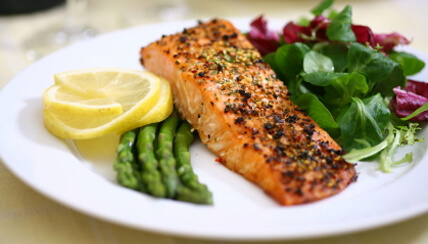Serving Size vs Portion Size
 A serving size is the amount of food defined by food manufacturer, restaurant or government. The serving size is listed on all food labels and gives you all the nutritional information for one serving size.
A serving size is the amount of food defined by food manufacturer, restaurant or government. The serving size is listed on all food labels and gives you all the nutritional information for one serving size.
A portion size, on the other hand, is the amount of food you serve yourself. It may be more or less than one serving. Be aware of how your portion relates to the serving size. Is it one serving, two, three, a half?
Serving Size Tips
Use these everyday comparisons to help you figure out the serving size of what you are eating:
- 1 cup of cereal = a fist
- 2 tablespoons of peanut butter = a ping-pong ball
- 3 ounces of meat= a deck of cards or the size of your palm
- 1 medium fruit = a tennis ball
- 1 ounce of cheese = a finger
- 1 cup of pasta = a baseball
- 1 pancake = a DVD
- 1 ounce of nuts = one loose handful
- 1 teaspoon of butter/margarine = one die from a set of dice
What Counts as One Serving?
Grains (1 ounce = 1 serving) | Fruits (1 cup = 1 serving) | Vegetables (1 cup = 1 serving) | Dairy (1 cup = 1 serving) | Protein (1 ounce = 1 serving) |
1 slice of bread 1 cup dry cereal ½ cup cooked cereal ½ cup cooked pasta ½ cup cooked rice 5-6 wheat crackers ½ English muffin 1 small tortilla 1 “mini” bagel ¼ large bagel | 1 cup fresh fruit 1 cup 100% fruit juice
1/2 cup dried fruit 1 small whole fruit | 1 cup raw vegetables 1 cup cooked vegetables 2 cups raw leafy greens 1 medium potato 1 ear of corn | 8oz. milk 8oz. yogurt 1 ½ oz. cheese | 1 oz. meat, poultry, fish ¼ cup cooked dry beans 1 egg ½ oz. nuts or seeds 1 tbsp. peanut butter |
| Eat 3-4 servings/day | Eat 1 ½- 2 cups/day | Eat 2-2 1/2 cups/day | Eat 2-3 cups/day | Eat 5-6 servings per day |
Practical Tips for Controlling Your Portion Size
Visual cues can help you manage your portion sizes. In general, the larger the container, the more people tend to eat.
- Buy food that comes in smaller packages.
- Trying to save money? Buy larger packages and then transfer the food into smaller containers.
- Use smaller plates, bowls, glasses and even silverware.
- Use tall, skinny glasses if you’re drinking a caloric beverage.
- Serve yourself the amount of food equal to one serving size first. Have another serving size if you are still hungry.
- Eat off of a plate or bowl and not out of the bag or box.
- Buy single-serving snack packages.
- Trying to save money? Make your own snack bags at home.
- Cook once a week and freeze amounts in a single serving or for a family meal another day.
- Leave the food in the kitchen when eating, rather than on your table. You will need to get up to get more, which will make you think about that second helping.
- When eating out consider sharing your meal, ordering a half-portion or ordering an appetizer as a main meal.
- At a restaurant, ask for a to-go box right away and put a portion of your meal in the box before eating so you will not be tempted to eat more than you need.
